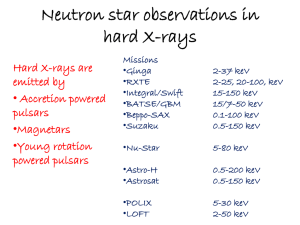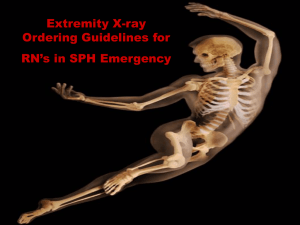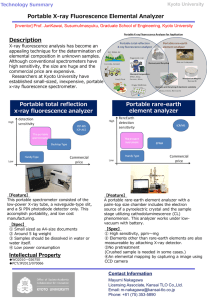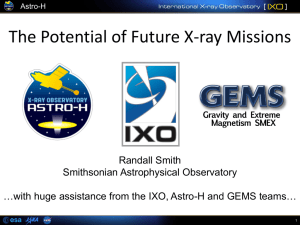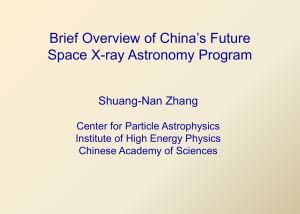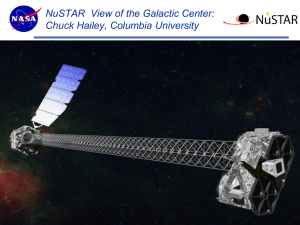X線天文学の課題と戦略 - (CTA) Japan
advertisement
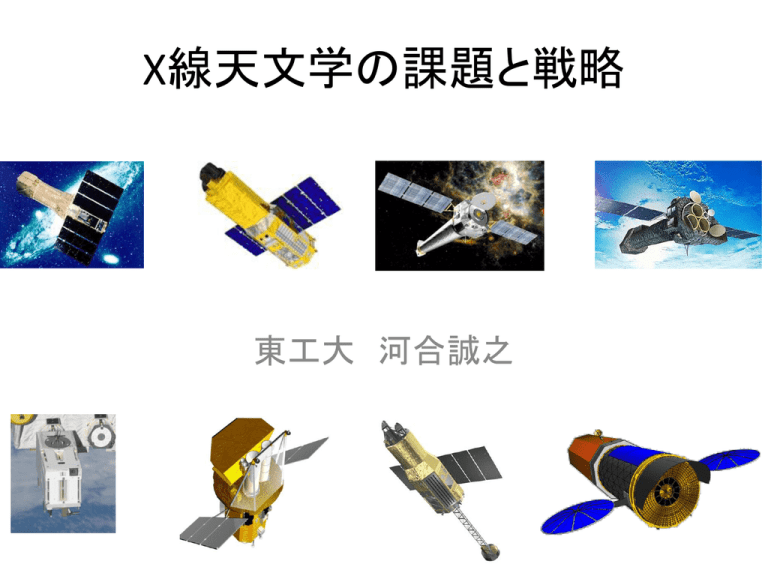
X線天文学の課題と戦略 東工大 河合誠之 X線天文学は終わったか • • • • • 新天体・新現象の発見がない ある ある 画期的な観測技術革新がない 届く (GRB, QSO) 宇宙の果てに届かない テーマがX線に閉じている 閉じない 金と時間がかかりすぎ なのはX線だけじゃない X線天文学による新発見 • 月掩蔽 • 新帯域 • 感度 • Timing • 多波長 • 感度 • 感度 • 全天監視• 軟X線 • 新帯域 Accreting X-ray source: Sco X-1 (1962) Pulsar wind nebula: Crab (1964) Cosmic X-ray background (1966) X rays from AGN (1970) Accreting X-ray pulsar: Cen X-3 (1971) Black hole: Cyg X-1 (1973) Stellar corona (1975) Hot gas in galaxy clusters (1976) X-ray bursts (1976) Local Hot Bubble (1977) X線天文学による新発見 即応• GRB X-ray afterglow (1997) 多波長 帯域 • “Magnetar” = AXP+SGR (1998) 稀 解像度 • AGN jet imaging (2000) 長期 監視• Supergiant Fast X-ray Transient (2004) 解像度• Bubbles in galaxy clusters (2006) • Supernova shock breakout (2008) 稀 監視多波長 • X-ray echo of Galactic Center flare (1996–2009) 長期 分光撮像 • BH binaries + radio jets, g-ray flare (1996-2009) 監視多波長 長期 • Crab Nebular variation (2010) Swift Instruments Burst Alert Telescope (BAT) – 15-150 keV – 2 sr field of view – CdZnTe detectors – Most sensitive gamma-ray imager ever – Detect ~100 GRBs per year X-Ray Telescope (XRT) – 0.2-10 keV – Few arcsecond positions – CCD spectroscopy UV/Optical Telescope (UVOT) – 170 – 650 nm – Sub-arcsec positions – Grism spectroscopy – 6 UV/optical broad-band filters – 22nd mag sensitivity (filtered) Spacecraft UVOT BAT BAT XRT UVOT XRT Spacecraft – – Autonomous re-pointing, 20 - 75 sec Onboard and ground triggers Perseus Cluster of galaxies SN 2008D Shock Breakout SN 2007uy - XRT monitoring of NGC 2770 (27 Mpc) revealed extremely luminous X-ray outburst - EX ~ 2x1046 ergs - No BAT, no radio late >> probably no jets - UVOT detection of SN rising 90 min later - SN Ib/c - Shock breakout. May occur for all SN 9 Jan 2008 Soderberg et al. 2008 Fe line in the Sgr B2 region decayed in 10 years Sgr B2 is an X-ray reflection nebula Suzaku 6.4keV image • Sgr B2 region : size ~10 light years • 6.4 keV line: photoionized Fe Inui et al. 2009 X-ray tomography of molecular clouds Sgr A* light curve Current Lx~1033 erg/s Ryu et al. 2009, PASJ, 61, 751 Cyg X-3 Tavani al. 2009, Nature AGILE Flares (>100 MeV) Abdo et al. 2009, Science BAT (15-50 keV) ASM (2-12 keV) BAT (15-50 keV) Radio 15 GHz LAT Flux MAXI light curve of a new BH candidate XTE J1752-223 Radio Detection MAXI XTE J1752-223 observed by MAXI High energy emmission Disc Jet A model by Done et al (2007) Jet Jan 21 2010 The present 6month observation has revealed an evolution of the accretion disc of BH X-ray nova! Apr 10 2010 Oct 23 2009 Nakahira et al 2010 PASJ 12 Crab Nebula X-ray variation –7% in 2 years Wilson-Hodge 2010 現在運用中の衛星/実験 mission RXTE 分光 面積 計時 監視 探査 調査 緊急 対応 偏光 光学 ▲ △ ◎ ◎ ○ △ ◎ × × 撮 像 band M H XMM S M ○ ◎ ◎ ○ × △ △ × ○ Chandra S M ◎ ◎ ○ △ × △ △ × × H △ △ ○ ○ △ △ △ ▲ × Swift S M H ○ ○ ○ ○ ◎ ○ ◎ × ○ Suzaku S M H ○ ○ ◎ △ × × △ × × H × △ ◎ △ ○ × × × × △ △ ○ △ ◎ ○ × × × INTEGRAL Fermi MAXI S M X線天文学の利点 • 高エネルギー現象を既知の天体へ結びつける 最も確実な観測手段 • 宇宙物理学的理由 – 熱的・非熱的両過程の放射 – 透過力が強い – 光子数が多い • 技術的理由 – 斜入射反射鏡により結像 • 空間構造、高感度、放射源の分解、位置決定 – 高分散分光(回折格子、マイクロカロリメータ) • 運動学 • 温度、組成、密度 今後の衛星計画 • • • • • • • • • NuSTAR (米) 硬X線撮像 ASTROSAT (印+) 高計数計時、多波長 ASTRO-H (日米) GEMS (米) SRG (露独) HXMT(中) SVOM(中仏) … IXO 将来の衛星/実験 撮像 分光 面積 計時 監視 探査 調査 緊急 対応 偏光 光学 M H ○ ○ ○ ◎ × × ○ × × ASTROSAT SMH ○ ○ ◎ ◎ ○ × ○ × ○ ASTRO-H SMH ○ ◎ ○ △ × × △ × × M × △ ○ ○ × × ? ◎ × SM ○ ○ ○ △ × ◎ ? × × mission band NuSATR GEMS SRG HXMT H △ △ ◎ ○ × ◎ ? × × SVOM SMH ○ ○ ○ △ ◎ ○ ◎? × ○ JANUS M △ × × × ◎ × (×) × IR MAXI-2 S ○ ○ △ × ◎ ○ × × × DIOS S △ ◎ ○ ○ × ◎ ○ × × Origin SMH ○ ◎ ○ ○ ◎ × ◎ × IR IXO SMH ○ ◎ ◎ ◎ × × △ ? × US Decadal Survey Report Recommendation Large Scale Space Program - Prioritized 1. 2. 3. 4. Wide Field InfraRed Survey Telescope (WFIRST) Explorer Program Augmentation Laser Interferometer Space Antenna (LISA) International X-ray Observatory (IXO) Science Themes • Cosmic Dawn (Reionization, First galaxies/stars) • New World (Nearby habitable planets) • Physics of the Universe (DE, DM, Inflation, GR) WFIRST LISA Explorer SPICA IXO What does Astro2010 mean for X-ray Astronomy? • IXO recommended, but number four – probably not earlier than 2025 – fewer jobs in X-ray astronomy – lack of Big Theme (i.e. First BH) in immediate future • Explorer program recommended as number 2 – Med/Small explorer for focused science goals • ESA Cosmic Vision selection in parallel 個人的展望 • たぶん日本にはチャンス • X線の強みを活かせる次のステップは、高いエネルギー分解能と 解像力の両立 ASTRO-H マイクロカロリメータを発展させた中核ミッション – 反射鏡:XMMのような大面積、~10秒角の分解能 – 検出器:多画素化 >30x30 • 個別テーマで小規模国際協力 – 硬X線、γ線 – 突発天体に対応できるSwift後継ミッション – サーベイ X線天文学の今後の方向 • Big Themeの追求 – First Black Hole • 銀河形成/共進化、宇宙再電離 – Cosmology • 銀河団サーベイ、SZ効果 • さまざまな課題の追究 – – – – Cosmic Chemical Evolution (SNR, 銀河団, …) Accretion and Jets (X線連星, AGN, …) Neutron Star Equation of State Particle acceleration • 新現象・新天体の探索 – Rare events (突発現象の長期・大天域監視) – External trigger (γ、光、電波、GW, ν) X線とCTAとの連携 • Non-thermal source – 硬X線撮像、X線偏光 • 多波長連携 – 突発現象、時間変動 – 対応天体 (広帯域放射過程、分子雲、伴星、母銀河) • 長期+広天域モニター – 長期的相関 – 稀な天体現象の追跡観測 MAXI detections of two intense flares from Mrk421 Jan. 1, 2010 ~120 mCrab. Feb. 16, 2010 MAGIC flare ~164 mCrab. VERITAS ATel #2443 MAXI 2 – 4 keV (6 hour) F4-10 keV F2-4 keV F15-50 keV F2-4 keV 24 Isobe et al. 2010 PASJ 2. ASTRO-H X-ray Astronomy Satellite • Launch in 2014 ASTRO-H • Launch site: Tanegashima Space Center, Japan • Launch vehicle: JAXA H-IIA rocket • Orbit Altitude: 550km • Orbit Type: Approximate circular orbit • Orbit Inclination: ~31 degrees • Orbit Period: 96 minutes •Total Length: 14m • Mass: <2.6 metric ton • Power: <3500 W • Telemetry Rate: > 8 Mbps (X-band) • Recording Capacity: > 12 Gbits Suzaku (6m, 1.7t) • Mission life : > 3 years 2010/04/15 SRON 25 2. ASTRO-H Mission Objectives Observing the Dynamic Universe and Studying its History with the Ultimate Goal of Understanding the Structure and Evolution of the Universe Scientific objectives : •Revealing the large-scale structure and its evolution of the Universe •Understanding the extreme conditions in the Universe •Exploring the diverse phenomena of non-thermal Universe •Elucidating dark matter and dark energy Key features : •High resolution spectroscopy with Soft X-ray Spectrometer •Hard X-ray focusing imaging •High sensitive wide-band spectroscopy (0.5-600 keV) 2010/04/15 SRON 26 2. ASTRO-H Instruments Spectroscopy (for diffuse source) ASTRO-H Energy Energy Coverage Coverage Area for SoftX-rays Chandra SXT-S (telescope) SXS Soft X-ray Spectrometer System - 0.3-12 keV - Large Area Soft X-ray Telescope - X-ray micro calorimeter - super resolution (<7eV at 6 keV) SXT-I (telescope) Angular Resolution HXT (telescope) - 0.4-12 keV - Large Area Soft X-ray Telescope - Large FOV 38x38 arcmin2 - CCD spectroscopy 2010/04/15 SRON XMM Area for Hard X-rays HXI Hard X-ray Imaging System - Hard X-ray Telescope (5-80 keV) - Focal Length 12 m - New CdTe Imager (Fine Pitch Strip) SXI Soft X-ray Imaging System Suzaku SGD Soft Gamma-ray Detector - 10-600 keV non-imaging - Si/CdTe Compton Camera with Narrow FOV Active Shield - most sensitive gamma-ray detector ever 27 5. ASTRO-H Science Cluster of Galaxies 低バックグランド広視野 X線CCD観測 Dynamics (Turbulance, Collisions) Non-thermal Emission Cluster Outskirt (Site of Sturcture Formation) Temperature Map Heavy Metal Distribution Simulation of Centaurus Cluster To the virial radius, and beyond M.R. George et al. 2009 SXI FOV Astro-H will detect bulk velocity flow as small as 300 km/s in the brightest 30 clusters with T > 60 x 106 K (kT > 5 keV.) 2010/04/15 SRON 28 5. ASTRO-H -Performance - Supernova Remnants ASTRO-H 10-40 keV (100ks) SN1006 2-10 keV (Suzaku) Site of Particle Acceleration to map electon distribution with E=Emax RXJ1713 SN1006 by ASTRO-H Suzaku at 40 keV ASTRO-H at 40 keV by A.Bamba 2010/04/15 SRON 29 5. ASTRO-H -Performance - X. Sensitivity Imaging with hard X-ray optics will enable us to observe at x100 times higher sensitivity than Suzaku. 40-50% of the cosmic X-ray background will be resolved into hidden super-massive black holes. Obscured SMBH Bright • Soft Gamma-ray Spectrum up to several hundred keV by SGD for bright AGN Faint 2010/04/15 SRON 30 6. ASTRO-H Mission Status The ASTRO-H Project has been authorized to proceed into Phase C/D by the Japanese government (SAC : Space Activity Commission). SAC has confirmed that the ASTRO-H project is ready to proceed to the development phase. 2009/Jan-Feb : Science Working Group members (science advisors) selected by NASA(8), ESA(3) and JAXA(2) 2009/Feb. 25-27 : 1st Collaboration Meeting (Science Meeting/3rd Design Meeting) 2009/June 16: NASA entered Phase B 2010/Jan 5 : PASSed the SAC (Space Activity Commission) final-review 2010/Feb. 23-25: 2nd Collaboration Meeting 1. 2009 Sep- 2010 Jan: Sub System Level Review 2. 2010 Feb-Mar/April: System Level PDR 3. 2010 Nov-2011 April : MTM - TTM 4. 2011 Feb-Mar: CDR 5. 2013 Feb-Oct: Integration Test 6. 2014 Jan-Feb.: Launch (Planned) as of March/2010 2010/04/15 SRON



